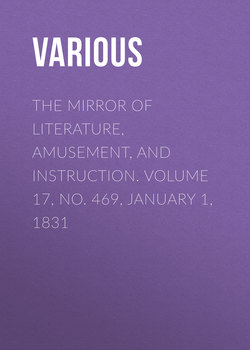Читать книгу The Mirror of Literature, Amusement, and Instruction. Volume 17, No. 469, January 1, 1831 - Various - Страница 3
The Topographer
ОглавлениеTRAVELLING NOTES IN SOUTH WALES
Vale of Tawy—Copper Works, &c.—Coal Trade.—In our former paper2 we gave a description of the Vale of Tawy, as it appears by night; we will now again revisit it. The stranger who explores this vale must expect to return with a bad headache. We have described it as a desolate looking place, when seen at night, but the darkness only throws a veil over its barrenness. The face of the country, which would otherwise have been beautiful, is literally scorched by the desolating effects of the copper smoke; and when it is considered that a multitude of flues are constantly emitting smoke and flames strongly impregnated with sulphur, arsenic, &c., it is not to be wondered at. A canal runs up the vale into the country for sixteen miles, to an elevation of 372 feet: it is flanked near the copper-works by many millions of tons of copper slag; and there are no less than thirty-six locks on the line. It is a fact, that in spite of the infernal atmosphere, a great many of the people employed in these works attain old age. Every evil effect about Swansea, however, is ascribed to the copper smoke. The houses in this district are remarkable for clean exterior: the custom of whitewashing the roofs, as well as the walls, produces a pleasing effect, and is a relief to the eye in such a desert. There are eight large copper smelting establishments, besides several rolling-mills, now at work; the whole country is covered with tram-roads and coal-pits, many of which vomit forth their mineral treasures close to the road side. At Landore, about two miles from Swansea, is a large steam-engine, made by Bolton and Watt, which was formerly the lion of the neighbourhood. This pumping engine draws the water from all the collieries in the vale, throwing up one hundred gallons of water at each stroke: it makes twelve strokes in a minute, and consequently discharges 72,000 gallons an hour. This engine, however, is very inferior in construction and finish to the pumping engines of Cornwall, some of which are nearly three hundred horsepower. At the consols mines, there are two engines, each with cylinders of ninety inches in diameter, and everything about them kept as clean as a drawing-room. What an extraordinary triumph of the ingenuity of man, when it is considered that one of these gigantic engines can be stopped in an instant, by the mere application of the fingers and thumb of the engineer to a screw! The quantity of coals consumed by the copper-works is enormous. We have heard that Messrs. Vivians, who have the largest works on the river, alone consume 40,000 tons annually: this coal is all small, and not fit for exportation. The copper trade may be considered as comparatively of modern date. The first smelting works were erected at Swansea, about a century ago; but now it is calculated that they support, including the collieries and shipping dependant on them, 10,000 persons, and that 3,000l. is circulated weekly by their means in this district. Till within the last few years, there were considerable copper smelting establishments at Hayle, in Cornwall; but that county possessing no coals, they were obliged to be abandoned, as it was found to be much cheaper to bring the ore to the coal than the latter to the ore. Formerly, from the want of machinery to drain the water from the workings (copper being generally found at a much greater depth than tin), the miners were compelled to relinquish the metallic vein before reaching the copper: indeed, when it was first discovered, and even so late as 1735, they were so ignorant of its value, that a Mr. Coster, a mineralogist in Bristol, observing large quantities of it lying amongst the heaps of rubbish round the tin mines, contracted to purchase as much of it as could be supplied, and continued to gain by Cornish ignorance for a considerable time. The first discoverer of the ore was called Poder (it long went by his name), who actually abandoned the mine in consequence; and we find that it was for some time considered that "the ore came in and spoilt the tin." In the year 1822 the produce of the Cornish copper mines amounted to 106,723 tons of ore, which produced 9,331 tons of copper, and 676,285l. in money. In the same year, the quantity of tin ore raised was only 20,000 tons. The Irish and Welsh ores are generally much richer than those of Cornwall; but occasionally they strike on a very rich lode (or vein) in that county. Last spring, some ore from the Penstruthal mine was ticketed at Truro, at the enormous price of 54l. 14s. per ton; and a short time previous, in the Great St. George Mine, near St. Agnes, a lode was struck five feet thick, which was worth 20l.
2
See Mirror, vol. xvi.
